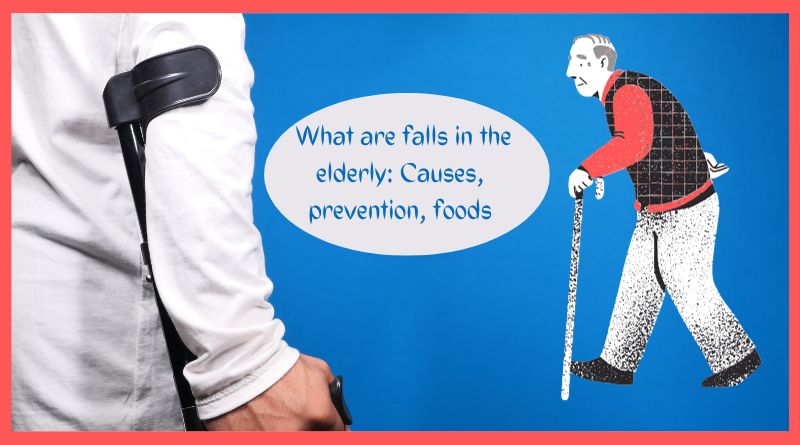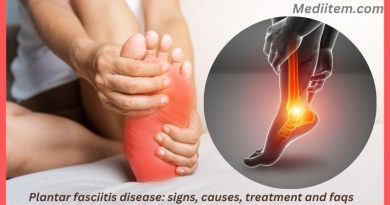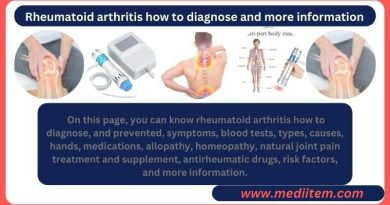What are falls in the elderly: Causes, prevention, foods
How to avoid falls in the elderly:
It is estimated that one in 10 seniors in the European Union is treated by a doctor for an injury and the majority of these occur in the form of falls in the elderly. What’s more, it is the main cause of injury in the elderly and therefore we must be aware. How to avoid falls in the elderly.
Aging is associated with a greater probability of suffering falls, which are usually the first indicator of a serious problem and are associated with injuries, disability, institutionalization, and even death.
The reasons why the elderly can fall more easily are:
Loss of information through the senses, because they hear and see worse.
Progressive loss of sense of balance.
Loss of muscle strength.
Difficulties with coordination, especially if they suffer from a neurological disease.
On the other hand, the consequences of falls also tend to be worse: osteoporosis causes fragility in bones and joints, as well as difficulties in healing. Breakage of the hip or long bones, such as the femur, is one of its most common consequences, with the complications that its treatment entails in an elderly person, with multiple pathologies or a degree of dependency.
Do you want to know how to avoid falls in elderly and/or dependent people? Below, we offer you a series of tips and recommendations that you can put into practice to minimize the risks.
What are falls in the elderly?
According to the World Health Organization (WHO), “falls are involuntary movements that cause loss of balance.” All of them can be dangerous, but in older adults, they are more frequent and dangerous.
Generally, these types of accidents in elderly people are caused by aging and illness. And not only does it have health consequences, but it can also cause psychological effects on the affected person.
Main causes of falls in the elderly
Although falls can occur in people of any age, older adults are more likely to suffer greater consequences. Below are the main risk factors:
Read more: health benefits of garlic supplement
Risk factors for falls in the elderly
Falls in the elderly are not an unpredictable or inevitable event, it is one of the most frequent problems in the elderly population. Half have recurrent falls, falling again in the same year. Falling is a risk factor for suffering new falls.
The WHO defines falls as a consequence of any event that precipitates the patient to the ground against their will.
It is a fact that the risk of falling increases with age, specifically 30% of those over 65 years of age suffer a fall once a year, this percentage increases to 35% of those over 75 years of age and rises to 50%. % in people over 80 years of age.
Other additional data on falls in people over 65 years of age indicate that the death rate from falls increases with increasing age; they are more frequent in women, although as the years progress they equalize.
In nursing homes, like Montesalud, we take into account that falls occur at any time during the most normal daily activities.
Read more: plantar fasciitis disease- signs, cause, treatment and faqs
Risk factors for falls in the elderly
Intrinsic causes (related to the patient himself)
Alteration of gait, difficulty in mobility.
Visual and auditory alteration
Cognitive impairments (spatiotemporal disorientation)
Neurological problems (slow reflexes, increased reaction time, altered compression…)
Extrinsic causes (depend on the environment and environment)
Circumstantial factors (depend on the activities carried out)
Fall log
Recording falls in the elderly is essential to detect as many risk factors as possible that may intervene.
Safety measures to prevent falls in the elderly people
Correct preventive safety measures such as railings in hallways and beds, well-protected stairs, obstacles-free facilities, self-protection measures, signs and posters indicating danger, help residents have a safer day-to-day life.
In addition, there are prevention therapies to guarantee the autonomy of the elderly, which reinforce musculoskeletal function, and improve postural stability and reaction speed through different activities.
In addition, thanks to them you can learn how to fall and get up under the supervision of professional therapists.
Can falls in the elderly be avoided?
Falling is a very normal phenomenon in the elderly. A third of people over 65 years of age suffer a fall every year and half relapse again. The annual incidence of falls among the population aged 65-70 is 25%, rising to 47% after age 75. This incidence is higher in women up to age 75.
Falls are the main cause of hip fractures in the elderly. This demonstrates the great current social problem.
Prevention of falls in the elderly
Primary Prevention: those measures aimed at preventing falls.
Secondary Prevention: this begins when the elderly person has already suffered a fall and the factors that may have influenced it are sought.
Tertiary Prevention: this is based on reducing disability, all those rehabilitative measures that try to reduce the physical and psychological consequences of the fall.
If we maintain regular physical activity and a balanced diet, there will be 2 factors that will protect us from falls.
How to limit the risk of falls in the elderly?
We invite you to watch our video on Fall Prevention where we develop this article in depth:
Since the action of falling is multifactorial, to carry out fall prevention, we must intervene at different levels:
1. Adopt a healthy diet and good hydration:
It is very important to maintain a muscular and skeletal system in good condition, reducing the risk of fractures in the event of falls. We must include foods rich in Zinc, Calcium, Selenium, Vitamin D, Vitamin B9, and B12 that will help us keep our brain, bones, and muscles in good condition.
2. Stay physically active:
Lack of physical activity causes osteoporosis, a decrease in muscle mass, coordination, balance, and the speed of execution of tasks.
In addition to walking, which is an excellent physical activity, there are a series of simple and very useful exercises that you can do every day at home. Consult your physical therapist for a correct schedule of these exercises according to your current health status and needs.
3. Control your medication intake and have good monitoring by your family doctor:
We must keep in mind that taking 4 or more medications a day is associated with a greater risk of falling; it is necessary to adjust the doses well to each person and be aware of the possible side effects and interactions.
4. Modify your home to facilitate travel and security:
There are many small measures that we can take to prevent falls in our homes:
*Wear comfortable shoes that support the foot well and have rubber soles, avoiding flip-flops, high heels, and slippery soles.
*Eliminate carpets at home.
*Be especially careful with stairs, always holding on to the handrail.
*If necessary, install handrails in the bathroom, near the toilet, and in the shower.
*Change the bathtub to shower and use a non-slip mat.
*At night, keep the light switch within reach and get out of bed very slowly.
*Ensure good lighting throughout the house.
*Buy a wireless phone that prevents you from having to run to answer and also be able to use it in case of a fall.
*If you live alone, it would be convenient to have telecare.
5. Use, if necessary, the technical walking aid that best suits your physical condition:
Nowadays we have at our disposal walking aids that will make our movements easier and give us greater stability, such as canes, crutches, walkers… We can also find orthoses, knee pads, and other products that will reduce pain and promote correct mobility. of our joints helping to prevent falls.
Tips for falls in the elderly
Therefore, after analyzing the previous reasons, it is advisable to follow a series of guidelines and preventions to avoid suffering falls and their consequences, such as:
General:
Fall prevention strategies at home
In the bathroom (one of the most dangerous places)
- Placing fixed handrails in the bathtub, toilet, etc
- Placing rubber mats in the bathtub to prevent slipping
- Towel racks must be fixed to the wall in order to fulfill the same function as the bathtub railing.
- Do not lock the bathroom door, so that in case of danger, someone can come in to help
Older people, by changing their habits a little and with a few small safety and prevention measures, can avoid falls and their serious physical consequences.
Know 5 injuries that occur in older adults
1/ Head injuries, an action that can cause a traumatic brain injury. Causing everything from seizures, and cognitive impairment to constant mood swings.
2/ Fractures due to frequent use of a medication called Alendronate, which is used in the treatment of osteoporosis. But, with continued use, bones become too hard, causing them to splinter from the pressure.
3/ Hip fractures, which depending on the degree of severity may include implantation of a prosthesis.
4/ Fractures and sprains, can cause everything from sprains in the ankle, not the knee, to sprains in the connective ligaments in the joints.
5/ Injuries to the spinal cord and back cause a limit to your mobility and depending on the type of fall, it can cause permanent paralysis and some sensory deficiencies.
Elderly deterioration after fall
People at low risk of falls:
Those with a negative response to the three screening questions.
They will be offered the same assessment and advice on regular physical activity and healthy eating offered to the non-frail autonomous population, included in the comprehensive advice on healthy lifestyles. A new fall risk assessment will be carried out every year.
People at high risk of falls in the elderly
Those with an affirmative answer to any of the three screening questions.
A preventive intervention focused on three components will be carried out:
Multi-component physical activity program (aerobic endurance, flexibility, balance, and muscle strength), integrated with the frailty prevention program.
Preventing falls in hospital
Elderly preventing falls in hospital: 40% of all falls that occur each year in the world occur in elderly adults, being one of the main causes of hospitalization and the first cause of accidental death in the elderly.
Although they carry out fewer risky behaviors and tend to have less physical activity, the elderly are also an age group that is especially vulnerable to falls, both due to the greater risk and the consequences that can arise from these accidents.
Focused on the review of drugs that negatively affect people at risk of falls following the STOPP/START criteria. The drugs considered are benzodiazepines, neuroleptics, first-generation antihistamines (chlorpheniramine, diphenhydramine, hydroxyzine, promethazine, etc.), vasodilators, and chronically consumed opiates.
Review of home risks through referred checklists, assessment of the home opportunistically taking advantage of a home visit by center staff (nurse, social worker…).
Furthermore, people classified as high risk of falls could be subsidiaries of an individualized multifactorial assessment of the risks of falls and an individualized multicomponent intervention focused on the risks detected, within the programmed actions of the primary care team, with the characteristics and scope specific to each territorial reality.
Referral to hospital care (preferably geriatrics where the resource exists) will be considered for those people who meet any of the criteria set out above for the frail elderly person.
An annual evaluation of the intervention carried out will be carried out.
Read more: Top 20 Most Common Elderly Diseases With Solutions
Foods for falls in the elderly
Food that an older adult should eat to strengthen bones: Maintaining a good physical and mental appearance in older people is essential, which is why diet plays a very important role not only in terms of health but also in strengthening bones. Do you want to know what you should eat? We will tell you below:
| Nuts | Dairy | Broccoli | Avocado |
| Sardines | Spinach | Cereals | Eggs |
My YouTube



